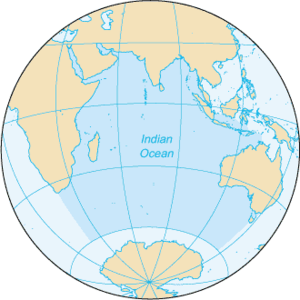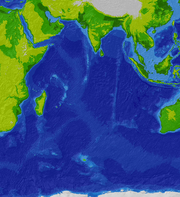Indian Ocean
2008/9 Schools Wikipedia Selection. Related subjects: Geography
| Earth's oceans ( World Ocean) |
|---|
The Indian Ocean is the third largest of the world's oceanic divisions, covering about 20% of the water on the Earth's surface. It is bounded on the north by Asia (including the Indian subcontinent, after which it is named); on the west by Africa; on the east by Indochina, the Sunda Islands, and Australia; and on the south by the Southern Ocean (or, traditionally, by Antarctica). One component of the all-encompassing World Ocean, the Indian Ocean is delineated from the Atlantic Ocean by the 20° east meridian running south from Cape Agulhas, and from the Pacific by the 147° east meridian. The northernmost extent of the Indian Ocean is approximately 30° north in the Persian Gulf and, thus, has asymmetric ocean circulation. This ocean is nearly 10,000 kilometres (6,200 mi) wide at the southern tips of Africa and Australia; its area is 73,556,000 square kilometres (32.1 mi), including the Red Sea and the Persian Gulf.
The ocean's volume is estimated to be 292,131,000 cubic kilometers (70,086,000 mi³). Small islands dot the continental rims. Island nations within the ocean are Madagascar (formerly Malagasy Republic), the world's fourth largest island; Comoros; Seychelles; Maldives; Mauritius; and Sri Lanka. Indonesia borders it on the east. The ocean's importance as a transit route between Asia and Africa has made it a scene of conflict. Because of its size, however, no nation had successfully dominated most of it until the early 1800s when the United Kingdom controlled much of the surrounding land. After the decline of the British Empire, the ocean has since been dominated by India and Australia.
Geography
The African, Indian, and Antarctic crustal plates converge in the Indian Ocean. Their junctures are marked by branches of the Mid-Oceanic Ridge forming an inverted Y, with the stem running south from the edge of the continental shelf near Mumbai, India. The eastern, western, and southern basins thus formed are subdivided into smaller basins by ridges. The ocean's continental shelves are narrow, averaging 200 kilometres (125 mi) in width. An exception is found off Australia's western coast, where the shelf width exceeds 1,000 kilometres (600 mi). The average depth of the ocean is 3,890 metres (12,760 ft). Its deepest point, is in the Diamantina Deep close to the coast of south west Western Australia. North of 50° south latitude, 86% of the main basin is covered by pelagic sediments, of which more than half is globigerina ooze. The remaining 14% is layered with terrigenous sediments. Glacial outwash dominates the extreme southern latitudes.
A spring 2000 decision by the International Hydrographic Organisation delimited a fifth world ocean, stripping the southern portions of the Indian Ocean. The new ocean extends from the coast of Antarctica north to 60° south latitude which coincides with the Antarctic Treaty Limit. The Indian Ocean remains the third-largest of the world's five oceans.
Major choke points include Bab el Mandeb, Strait of Hormuz, Strait of Malacca, southern access to the Suez Canal, and the Lombok Strait. Seas include Andaman Sea, Arabian Sea, Bay of Bengal, Great Australian Bight, Gulf of Aden, Gulf of Oman, Laccadive Sea, Mozambique Channel, Persian Gulf, Red Sea, Strait of Malacca, and other tributary water bodies.
Climate
The climate north of the equator is affected by a monsoon or tornado wind system. Strong north-east winds blow from October until April; from May until October south and west winds prevail. In the Arabian Sea the violent monsoon brings rain to the Indian subcontinent. In the southern hemisphere the winds generally are milder, but summer storms near Mauritius can be severe. When the monsoon winds change, cyclones sometimes strike the shores of the Arabian Sea and the Bay of Bengal. The Indian Ocean is the warmest ocean in the world.
Hydrology
Among the few large rivers flowing into the Indian Ocean are the Zambezi, Shatt al-Arab, Indus, Ganges, Brahmaputra, Juba and Ayeyarwady River. Currents are mainly controlled by the monsoon. Two large circular currents, one in the northern hemisphere flowing clockwise and one south of the equator moving anticlockwise, constitute the dominant flow pattern. During the winter monsoon, however, currents in the north are reversed. Deep water circulation is controlled primarily by inflows from the Atlantic Ocean, the Red Sea, and Antarctic currents. North of 20° south latitude the minimum surface temperature is 22 °C (72 °F), exceeding 28 °C (82 °F) to the east. Southward of 40° south latitude, temperatures drop quickly. Surface water salinity ranges from 32 to 37 parts per 1000, the highest occurring in the Arabian Sea and in a belt between southern Africa and south-western Australia. Pack ice and icebergs are found throughout the year south of about 65° south latitude. The average northern limit of icebergs is 45° south latitude.
Sub surface features
As the youngest of the major oceans has active spreading ridges :-
- Carlsberg, Southwest Indian Ridge, Southeast Indian Ridge and the Mid Indian Ridges
Economy
The Indian Ocean provides major sea routes connecting the Middle East, Africa, and East Asia with Europe and the Americas. It carries a particularly heavy traffic of petroleum and petroleum products from the oil fields of the Persian Gulf and Indonesia. Large reserves of hydrocarbons are being tapped in the offshore areas of Saudi Arabia, Iran, India, and Western Australia. An estimated 40% of the world's offshore oil production comes from the Indian Ocean. Beach sands rich in heavy minerals, and offshore placer deposits are actively exploited by bordering countries, particularly India, South Africa, Indonesia, Sri Lanka, and Thailand.
The warmth of the Indian Ocean keeps phytoplankton production low, except along the northern fringe and in a few scattered spots elsewhere; life in the ocean is thus limited. Fishing is confined to subsistence levels. Its fish are of great and growing importance to the bordering countries for domestic consumption and export. Fishing fleets from Russia, Japan, South Korea, and Taiwan also exploit the Indian Ocean, mainly for shrimp and tuna.
Endangered marine species include the dugong, seals, turtles, and whales.
Oil and ship pollution threatens the Arabian Sea, Persian Gulf, and Red Sea,
History
The world's earliest civilizations in Mesopotamia (beginning with Sumer), ancient Egypt, and the Indian subcontinent (beginning with the Indus Valley civilization), which began along the valleys of the Tigris-Euphrates, Nile and Indus rivers respectively, had all developed around the Indian Ocean. Civilizations soon arose in Persia (beginning with Elam) and later in Southeast Asia (beginning with Funan). During Egypt's first dynasty (c. 3000 BC), sailors were sent out onto its waters, journeying to Punt, thought to be part of present-day Somalia. Returning ships brought gold and myrrh. The earliest known maritime trade between Mesopotamia and the Indus Valley (c. 2500 BC) was conducted along the Indian Ocean. Phoenicians of the late 3rd millennium BC may have entered the area, but no settlements resulted.
The Indian Ocean is far calmer and thus opened to trade earlier than the Atlantic or Pacific Oceans. The powerful monsoons also meant ships could easily sail west early in the season, then wait a few months and return eastwards. This allowed Indonesian peoples to cross the Indian Ocean to settle in Madagascar.
In the second or first century BC, Eudoxus of Cyzicus was the first Greek to cross the Indian Ocean. Hippalus is said to have discovered the direct route from Arabia to India around this time. During the first and second centuries intensive trade relations developed between Roman Egypt and the Tamil kingdoms of the Cheras, Cholas and Pandyas in Southern India. Like the Indonesian peoples above, the western sailors used the monsoon to cross the ocean. The unknown author of the Periplus of the Erythraean Sea describes this route and the ports and trade goods along the coasts of Africa and India around AD 70.
From 1405 to 1433, Admiral Zheng He led large fleets of the Ming Dynasty on several voyages to the Western Ocean (Chinese name for the Indian Ocean) and reached the coastal country of East Africa. (see Zheng He for reference).
In 1497, Vasco da Gama rounded the Cape of Good Hope, and became the first European to sail to India. The European ships, armed with heavy cannon, quickly dominated trade. Portugal at first attempted to achieve pre-eminence by setting up forts at the important straits and ports. But the small nation was unable to support such a vast project, and they were replaced in the mid-17th century by other European powers. The Dutch East India Company (1602-1798) sought control of trade with the East across the Indian Ocean. France and Britain established trade companies for the area. Eventually Britain became the principal power and by 1815 dominated the area.
The opening of the Suez Canal in 1869 revived European interest in the East, but no nation was successful in establishing trade dominance. Since World War II the United Kingdom has withdrawn from the area, to be only partially replaced by India, the USSR, and the United States. The last two have tried to establish hegemony by negotiating for naval base sites. Developing countries bordering the ocean, however, seek to have it made a "zone of peace" so that they may use its shipping lanes freely, though the United Kingdom and United States maintain a military base on Diego Garcia atoll in the middle of the Indian Ocean.
On December 26, 2004, the countries surrounding the Indian Ocean were hit by a tsunami caused by the 2004 Indian Ocean earthquake. The waves resulted in more than 226,000 deaths and over 1 million were left homeless.
Culture and literature
The Indian Ocean is known as Ratnakara in the ancient Sanskrit literature. Ratnakara means "the maker(creator) of jewels".
- See Culture of the Indian Ocean Islands and Indian Ocean literature

